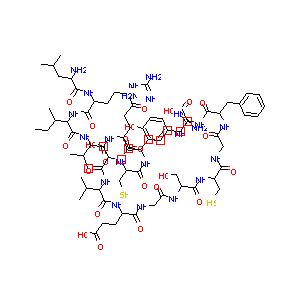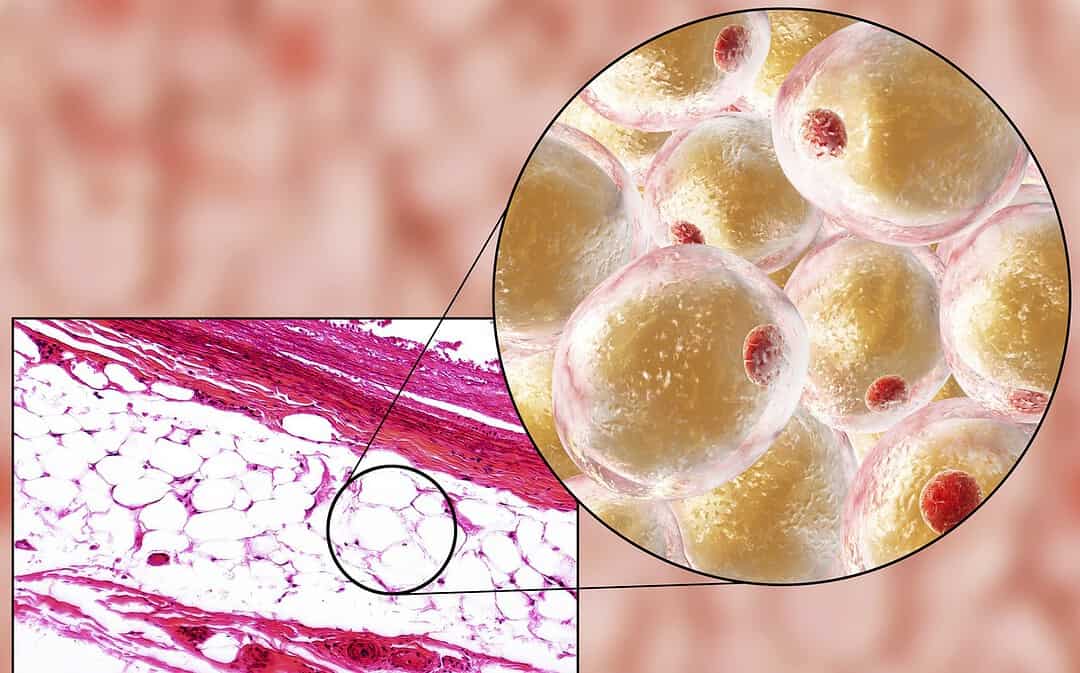Originating from the modification of the growth hormone’s last 16 amino acids (176-191), this peptide, alternatively known as GH Fragment 176-191 or AOD 9604, has garnered attention for its distinctive potential. The incorporation of a tyrosine residue at the N-terminus further contributes to the peptide’s stability, as suggested by researchers.(1)
This lipolytic fragment of hGH reportedly exhibits varied potentials within its 191 amino acid structure. Notably, studies highlight the insulin-potentiating action associated with the N-terminal region, while amino acids 108-129 elicit high mitogenic responses.(2)
AOD 9604’s designation as a modified version of fragment 176-191 positions it to potentially induce lipolysis, possibly without significant impacts on insulin and IGF-1 levels, mitigating potential risks associated with glucose intolerance and diabetes. Moreover, the structural similarity between AOD 9604 and HGH appears to minimize the likelihood of antibody formation.(3)

Fig 1. AOD 9604 Chemical Structure
Mechanism of Action
The mechanism of action of AOD 9604 peptide appears to involve its synthetic derivation from growth hormone (hGH), which is considered to facilitate the modulation of metabolic processes.
AOD 9604 reportedly operates by eliciting lipolysis and inhibiting lipogenesis, thus promoting the breakdown of fat and impeding the formation of new fat stores. Notably, these effects are speculated to be achieved through oxidative pathways and may occur independently of the hGH receptor.(1)
AOD 9604 peptide appears to exert a weight-reducing potential without altering caloric intake or appetite and without adversely affecting insulin sensitivity. Research findings indicate that this peptide may potentially facilitate the release of fat from adipose tissue while concurrently mitigating the accumulation of new fat deposits. Such actions underscore the potential of AOD 9604 in research related to adiposity and its associated metabolic disturbances.
AOD 9604 and Lipolysis Research
Early investigations into the effects of AOD 9604 peptide involved studies conducted on obese mice over a period of 14 days. The findings of these studies reported a significant decrease in the research models’ body weight and adipose tissue accumulation subsequent to the intervention. Concurrently, an elevation in the levels of key lipolytic receptors, specifically beta(3)-adrenergic receptors (β3-AR), within adipocytes was observed. Such findings suggest a direct correlation between the reduction in adiposity and the augmented expression of β3-AR.
Notably, the lipolytic activity exhibited by AOD 9604 peptide appears analogous to that of growth hormone (hGH), implying a potential shared mechanism wherein both agents exhibit the capacity to upregulate suppressed lipolytic receptor levels in obese mice relative to their lean counterparts. To discern whether the lipolytic effects of AOD 9604 are solely contingent upon enhanced β3-AR expression, further investigations were conducted utilizing mice with genetically ablated lipolytic receptors. Subsequent analyses suggested that AOD 9604 peptide may exert a lipolytic action through mechanisms involving heightened energy expenditure and enhanced fat oxidation(1).
In a subsequent study conducted in 2000, the efficacy of AOD 9604 peptide was evaluated in obese Zucker rats through daily exposure over 19 consecutive days. Results from this investigation indicated that the peptide “reduced over 50% body weight gain of the animals in comparison with the control.” Further observation indicated heightened lipolytic activity within the adipose tissues of rats receiving AOD 9604 peptide, accompanied by an absence of notable disruptions in insulin sensitivity.(4)
AOD 9604 and Cellular Regeneration Research
In a study conducted in 2015, 32 white rabbits were divided into four groups of eight, each receiving either a placebo, AOD 9604 peptide alone, hyaluronic acid alone, or a combination of AOD 9604 and hyaluronic acid for a duration ranging from 4 to 7 weeks. Subsequent morphological and histopathological evaluations of the rabbits aimed to assess the extent of cartilage degeneration post-exposure. The findings indicated that rabbits exposed to the combination of AOD 9604 and hyaluronic acid appeared to have exhibited the least degeneration in cartilage tissue.
The purported mechanism underlying these regenerative effects may involve the modulation of cellular differentiation processes and the synthesis of proteins crucial for tissue repair. In vitro investigations have hinted at the potential of AOD 9604 to promote the differentiation of adipose-derived mesenchymal stem cells into osteogenic lineages, potentially facilitating bone regeneration. Additionally, experiments conducted on isolated bovine chondrocytes revealed an upregulation in the production of proteoglycans and collagen, fundamental components of the extracellular matrix essential for cartilage integrity.(6)
Moreover, data suggests that AOD 9604 may stimulate the differentiation of myoblasts into mature muscle cells, highlighting its putative role in muscle tissue repair processes.
AOD 9604 and Cancer Research
AOD 9604 may potentially support the anti-cancer efficacy of certain chemotherapeutic compounds. One study employed chitosan nanoparticles as carriers for both the chemotherapy compound and AOD 9604 peptide, hypothesizing that AOD 9604 may potentially facilitate the binding of the compound to multiple protein targets within breast cancer cells, thereby augmenting its anti-proliferative effects.
The study reportedly states that “dual-loaded Chitosan nanoparticles demonstrated greater anti-proliferative activity against a breast cancer cell line (MCF-7) than doxorubicin-loaded Chitosan”.(7) These findings suggest the potential of AOD 9604 in enhancing the efficacy of conventional anticancer agents while potentially minimizing off-target effects, warranting further exploration in cancer-related research.
Conclusion
The AOD 9604 peptide has been widely researched on a global scale for its potential lypolytic action, although the peptide has been suggested to enact other impacts outside of any metabolic activity. Researchers have studied the action of the peptide under contexts related to cancer cell proliferation and chemotherapy, tissue and cartilage repair, and muscle cell development.
NOTE: These products are intended for laboratory research use only. This peptide is not intended for personal use. Please review and adhere to our Terms and Conditions before ordering.
References:
- Heffernan M, Summers RJ, Thorburn A, Ogru E, Gianello R, Jiang WJ, Ng FM. The effects of human GH and its lipolytic fragment (AOD9604) on lipid metabolism following chronic treatment in obese mice and beta(3)-AR knock-out mice. Endocrinology. 2001 Dec;142(12):5182-9. doi: 10.1210/endo.142.12.8522. PMID: 11713213. https://pubmed.ncbi.nlm.nih.gov/11713213/
- MORé, M., KENLEY, D.. Safety and Metabolism of AOD9604, a Novel Nutraceutical Ingredient for Improved Metabolic Health. Journal of Endocrinology and Metabolism, North America, 4, jun. 2014 https://www.jofem.org/index.php/jofem/article/view/213/278.
- STIER, H., VOS, E., KENLEY, D.. Safety and Tolerability of the Hexadecapeptide AOD9604 in Humans. Journal of Endocrinology and Metabolism, North America, 3, apr. 2013. https://www.jofem.org/index.php/jofem/article/view/157
- Ng FM, Sun J, Sharma L, Libinaka R, Jiang WJ, Gianello R. Metabolic studies of a synthetic lipolytic domain (AOD9604) of human growth hormone. Horm Res. 2000;53(6):274-8. doi: 10.1159/000053183. PMID: 11146367. https://pubmed.ncbi.nlm.nih.gov/11146367/
- Medical and Life Sciences, Obesity drug codenamed AOD 9604 highly successful in trials, 16 December 2004. https://www.news-medical.net/news/2004/12/16/6878.aspx
- Dong Rak Kwon and GI Young Park, Effect of Intra-articular Injection of AOD9604 with or without Hyaluronic Acid in Rabbit Osteoarthritis Model, Annals of Clinical and Laboratory Science, Volume 45, July-August 2015. https://pubmed.ncbi.nlm.nih.gov/26275694/
- Habibullah, M. M., Mohan, S., Syed, N. K., Makeen, H. A., Jamal, Q. M. S., Alothaid, H., Bantun, F., Alhazmi, A., Hakamy, A., Kaabi, Y. A., Samlan, G., Lohani, M., Thangavel, N., & Al-Kasim, M. A. (2022). Human Growth Hormone Fragment 176-191 Peptide Enhances the Toxicity of Doxorubicin-Loaded Chitosan Nanoparticles Against MCF-7 Breast Cancer Cells. Drug design, development and therapy, 16, 1963–1974. https://doi.org/10.2147/DDDT.S367586
- Image source: Therapeutic Drug Database: https://idrblab.net/ttd/data/drug/details/D0O7XO

